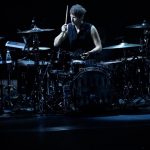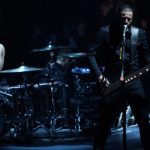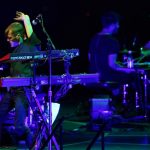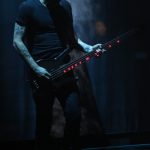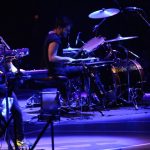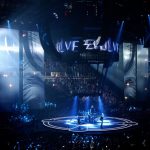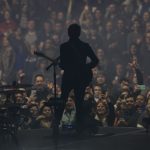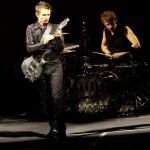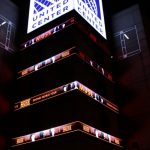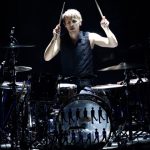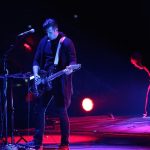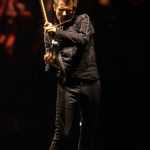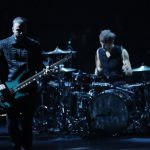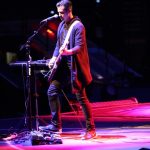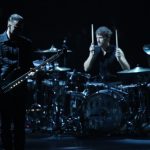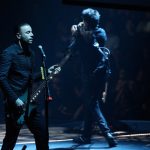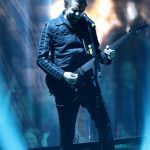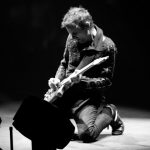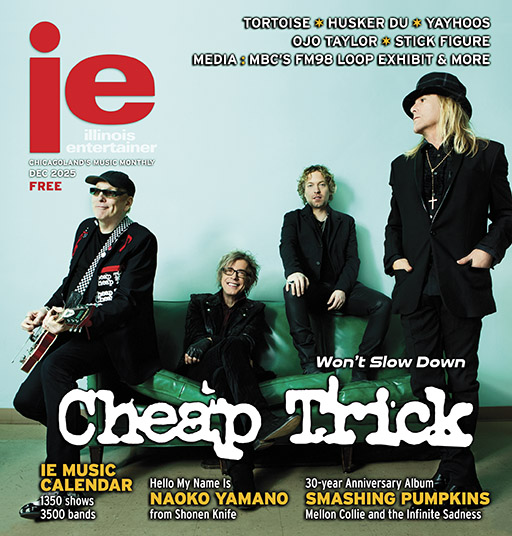Live Review & Photo Gallery: Muse @ United Center
Sharing a 20-year career, and a discography dating back to 1999’s Showbiz, and still-expanding relevance, English trio Muse draws a crowd of rock fans that truly spans all ages. If the group reminded some veteran concertgoers at the United Center of world-dominating acts including Queen and Pink Floyd (as suggested by at least a couple of t-shirts glimpsed around the cavernous hall), it’s no wonder. Like those hall-of-famers, Muse’s sound, presentation and ambition are so much larger than life that it’s hard to imagine they had humble origins like any other bar band. For anyone introduced to Muse through its stadium-smashing concert videos HAARP and Live at Rome Olympic Stadium, even an arena show could seem scaled down.
There was nothing stripped down about Wednesday’s cutting edge show on the Drones tour. Rather than placing a conventional platform at one end of the room, Muse’s black stage spanned the length of the floor. Dominic Howard’s drum set was the focal point of a rotating, illuminated center section. With raised platforms to the east and west of Howard, the playing territory looked like an electro-gothic nightmare of a bat taking flight.
During “Psycho,” guitarist/singer Matt Bellamy and bassist Chris Wolstenholme ran rings around Howard, playing to both sides and ends of the hall from various microphones. The song was the first chapter included from the Drones album’s anti-fascist storyline, unfolding a parable of individual and collective power against oppression and abusive authority. During a chat with fans via Twitter, Bellamy once described the album’s uniting theme, saying, “The world is run by drones, utilizing drones to turn us all into drones.” Fans shouted “Aye, sir!” in unison to video of the album’s caustic drill sergeant character.
Wolstenholme scaled the west platform to dig into the nimble and ferocious bass intro to “Hysteria” from Absolution. “I want it now,” sang Bellamy desperately, joined by thousands of voices from the room. The band added a thundering AC/DC riff to the end of the song.
Bellamy pogoed as Howard’s drum set slowly rotated during “Map of the Problematique” from Black Holes and Revelations. The song was a frustrated tirade against loneliness, but spoke to Bellamy’s recurring concept of brotherhood. “When we bleed, we bleed the same,” he sang in his tremulous tenor.
During “The Handler” from Drones, ominous eyes were projected over the hall while Bellamy and Wolstenholme performed beneath images of outstretched hands. One of the impressive light show’s most fascinating effects connected the musicians to these giant hands by illuminated strings that followed their every move, making them appear to be marionettes dancing for a malevolent puppeteer.
For many songs including “Resistance,” the band was augmented by a spare musician stationed in a sunken platform behind Howard’s drum throne. The multi-instrumentalist fleshed out arrangements with keyboards, guitar and percussion. All of the players were clad in black, fitting the show’s militant undertones by appearing as a musical special ops unit.
The dark funk of “Supermassive Black Hole” began with the riff to Jimi Hendrix’s “Voodoo Child (Slight Return).” It wasn’t the only reference to the virtuosic Bellamy’s influences on the guitar. “Reapers” included a dazzling solo that echoed Rage Against the Machine guitarist Tom Morello with its siren sweep.
“This is for you, Chicago,” said Bellamy before leading the entire hall in singing the anthemic “Starlight.” As the house lights came up to better see the crowd, the band sent enormous, black balloons into the bleachers. Although they initially appeared to be the most depressing beach balls ever, each produced a shower of glittering confetti as they burst.
Howard left his drum set to play the icy new wave groove to “Madness,” standing behind an electronic drum pad. The early, understated movements of the song were reminiscent of minimalist, deconstructed favorites like U2’s “Numb” or Prince’s “When Doves Cry” before erupting into an explosive coda.
Howard’s powerhouse percussion anchored the swinging Gary Glitter rhythm of “Uprising,” a song which provided another impassioned rallying cry shared between the band and audience. “They will not force us … we will be victorious!” sang the crowd with enough energy and volume to shout down the venue’s massive speaker system.
During “The Globalist,” an ominous black drone flew around the hall, sweeping a spotlight into guilty faces below. It was an image worthy of Pink Floyd’s “Another Brick in the Wall.” Bellamy performed the song at a plexiglass-topped baby grand piano atop the west riser, reveling in pomp reminiscent of the crescendo to “Hey Jude” or the recently departed David Bowie’s “All the Young Dudes.”
As confetti cannons fired into the room, one fan on the floor twirled into the falling streamers until he appeared to be a dancing, red-and-white version of Sigmund the Sea Monster. The show concluded with the majestic and bombastic “Knights of Cydonia,” galloping like a hyper-charged Ennio Morricone soundtrack combined with Queen’s “Keep Yourself Alive.” “You and I must fight to survive,” sang Bellamy with his choir of thousands, ending with a final note of solidarity and courage for the fans to take home.
Openers X Ambassadors were warmly greeted by Muse fans – seduced by their dynamic, yet stripped-down alt-rock and powered by their radio hit (and Jeep commercial) “Renegades.”
Review by Jeff Elbel, Photos by Curt Baran
- X Ambassadors
- X Ambassadors
- X Ambassadors
- X Ambassadors
- X Ambassadors
- X Ambassadors
Category: Featured, Stage Buzz, Weekly




